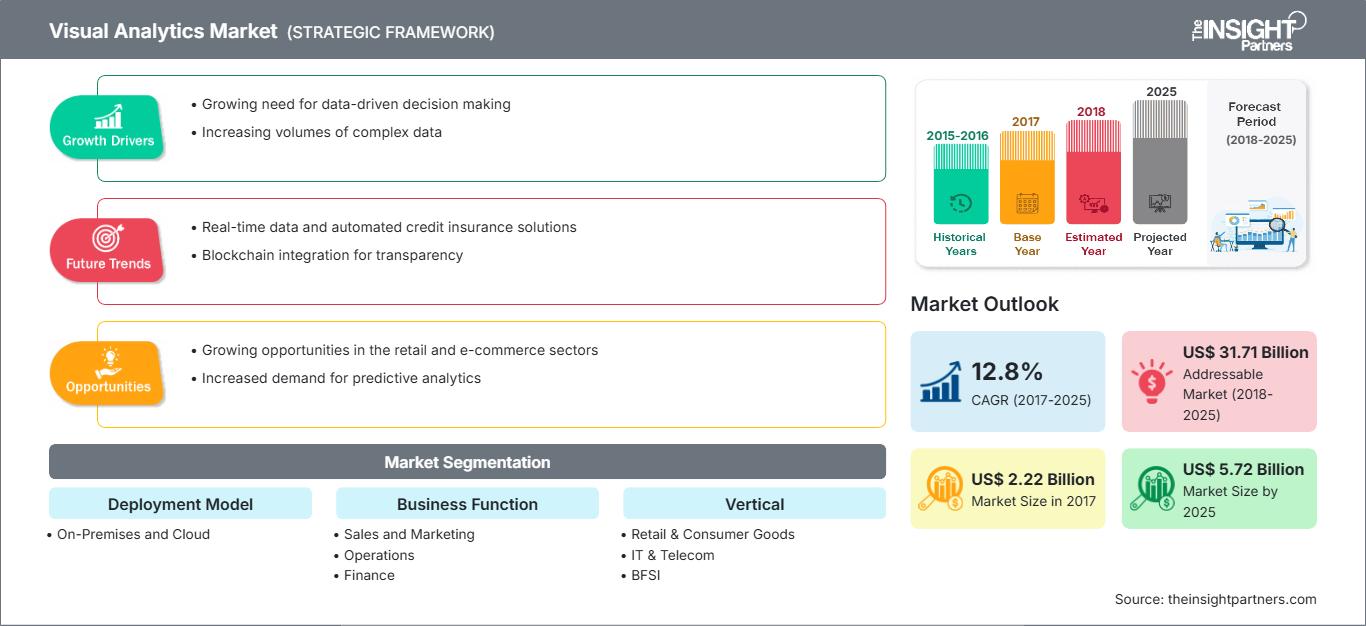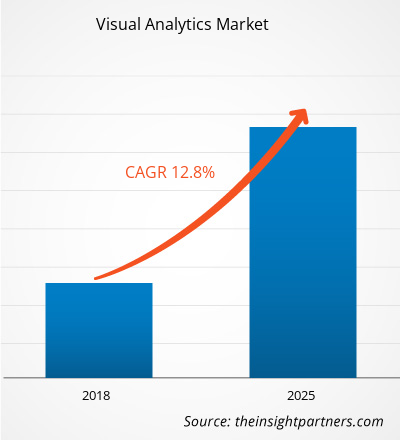[調査レポート]ビジュアル分析市場は2017年に2億2,150万米ドルと評価され、2025年には5億7,1860万米ドルに達すると予測されています。ビジュアル分析市場は、2017年から2025年の予測期間中に12.8%のCAGRで成長すると見込まれています。
視覚化とインタラクティブ分析を組み合わせて大規模なデータセットを探索することが、ビジュアル分析ソリューションの全体的な目標です。言い換えれば、ビジュアル分析とは、インタラクティブなビジュアルインターフェースによって促進される分析的推論の科学です。より正確に言うと、ビジュアル分析は、情報収集、データ前処理、知識表現、対話、意思決定を含む反復的なプロセスです。最終的な目標は、異種のソースからの膨大な量の科学的、法医学的、またはビジネスデータによって説明される目の前の問題に対する洞察を得ることです。この目標を達成するために、ビジュアル分析は機械の強みと人間の強みを組み合わせています。データベースにおける知識発見(KDD)、統計、数学などの手法が自動分析の原動力となっている一方で、人間の知覚、関連付け、結論を出す能力は、ビジュアル分析を非常に有望な研究分野へと変えています。今日では、単なるデータ視覚化だけでは不十分であり、企業はデータ視覚化と統合されたデータ駆動型分析機能を期待しています。ビジュアル分析は、手作業による情報操作と組み合わされた知的なビジュアルメタファーの形成として説明できます。
ビジュアル分析市場は、導入モデル、業務機能、および垂直市場に基づいて細分化されています。導入モデルに基づいて、ビジュアル分析市場はオンプレミスとクラウドに分類されています。業務機能に基づいて、ビジュアル分析市場は営業・マーケティング、運用、財務、サプライチェーン、情報技術、CRM、人事に分類されています。市場はさらに垂直市場に基づいて、小売・消費財、IT・通信、BFSI、製造、エネルギー・公益事業、ヘルスケア、政府機関に分類されています。地理的に見ると、市場は北米、ヨーロッパ、アジア太平洋、中東およびアフリカ、南米の 5 つの地域に分かれています。
要件に合わせてレポートをカスタマイズ
レポートの一部、国レベルの分析、Excelデータパックなどを含め、スタートアップ&大学向けに特別オファーや割引もご利用いただけます(無償)
ビジュアルアナリティクス市場: 戦略的洞察

- このレポートの主要な市場動向を入手してください。この無料サンプルには、市場動向から見積もりや予測に至るまでのデータ分析が含まれます。
ビジュアル分析市場の洞察:AIと機械学習の世界的な普及状況
レポートの一部、国レベルの分析、Excelデータパックなどを含め、スタートアップ&大学向けに特別オファーや割引もご利用いただけます(無償)
ビジュアルアナリティクス市場: 戦略的洞察

- このレポートの主要な市場動向を入手してください。この無料サンプルには、市場動向から見積もりや予測に至るまでのデータ分析が含まれます。
今日のデータ視覚化と分析のイノベーションに影響を与える最大のトレンドは、人工知能(AI)と機械学習の普及です。人間の制御を手放すことにためらいを抱くIT部門やアナリストにとっては恐ろしいように聞こえるかもしれませんが、AIとML機能を備えた分析プラットフォームは、実際には現代のアナリストにとって非常に効果的なアシスタントとして機能するでしょう。置き換えられるのではないかという懸念もあるかもしれませんが、機械学習は実際にはアナリストの能力を大幅に強化し、より効率的で、より正確になり、ビジネスへの影響力を高めます。機械学習テクノロジーを恐れるのではなく、それがもたらす機会を積極的に活用しましょう。
導入モデルに基づく市場の洞察
ビジュアル分析は、クラウドとオンプレミスの導入モデルで構成されます。ビジュアル分析の導入モデルは、特定のモデルを選択する上で重要な決定要因です。企業は、さまざまな要因に応じて、クラウドとオンプレミスの両方の導入モードを好みます。クラウドベースのビジュアル分析は、価格が手頃なため、多くの中小企業が最適な導入方法として好んでいます。
ビジネス機能ベースの市場インサイト
ビジネスアプローチのパラダイムシフトにより、世界中の、特に先進地域で、さまざまな業界の垂直市場で、ビジネスプロセスにさまざまな分析ソフトウェアを統合することへの需要が高まっています。今日のビジネスユーザーは、従来のデータ管理、処理、分析手法から大きく進歩しています。特定のセクターのさまざまなビジネス機能では、さまざまな目的でデータを分析する必要があります。
垂直市場インサイト
ビジュアル分析ツールの基本的な機能は、複雑なデータを取得し、それを非常にインタラクティブで理解しやすい方法でユーザーに提示することです。ビジュアル分析ツールには、データの視覚化と分析という2つの重要なタスクを実行する必要があります。単純な視覚化では、大量のデータを簡素化する問題を解決できません。これらのツールの使いやすさ、費用対効果、ビジュアル分析ツールのカスタマイズ性、インタラクティブなユーザーインターフェース、ダッシュボード、フィルタリングオプションなどは、エンドユーザーが自社のビジネス機能に適したビジュアル分析ツールを選択する際に考慮すべき要素です。
ビジュアル分析市場で事業を展開する企業は、市場開拓、買収、製品発売といった戦略に注力することで、ビジュアル分析市場における地位を維持しています。ビジュアル分析市場の主要企業による開発事例は以下のとおりです。
2018年9月、TIBCOはTIBCO Spotfire向けのA(X) Experienceを発表しました。これにより、データストリームのリアルタイムビジュアル分析が可能になり、リアルタイムの認識と対応が可能になります。
2018年9月、SAP SEはSAP Analytics Cloudを発表しました。これは、あらゆる分析を1つのシンプルなクラウドで実現するものです。この分析クラウドは、データの視覚化、予測、計画機能をオールインワンで統合した機能を顧客に提供します。
ビジュアル分析市場の地域別分析
予測期間を通じてビジュアルアナリティクス市場に影響を与える地域的なトレンドと要因については、The Insight Partnersのアナリストが詳細に解説しています。このセクションでは、北米、ヨーロッパ、アジア太平洋、中東・アフリカ、中南米におけるビジュアルアナリティクス市場のセグメントと地域についても解説しています。
ビジュアルアナリティクス市場レポートの範囲
| レポート属性 | 詳細 |
|---|---|
| の市場規模 2017 | US$ 2.22 Billion |
| 市場規模別 2025 | US$ 5.72 Billion |
| 世界的なCAGR (2017 - 2025) | 12.8% |
| 過去データ | 2015-2016 |
| 予測期間 | 2018-2025 |
| 対象セグメント |
By 展開モデル
|
| 対象地域と国 | 北米
|
| 市場リーダーと主要企業の概要 |
|
ビジュアル分析市場のプレーヤー密度:ビジネスダイナミクスへの影響を理解する
ビジュアルアナリティクス市場は、消費者の嗜好の変化、技術の進歩、製品メリットの認知度向上といった要因によるエンドユーザーの需要増加に牽引され、急速に成長しています。需要の高まりに伴い、企業は提供内容の拡充、消費者ニーズへの対応のためのイノベーション、そして新たなトレンドの活用を進めており、これが市場の成長をさらに加速させています。

- 入手 ビジュアルアナリティクス市場 主要プレーヤーの概要
- オンプレミス
- クラウド
ビジュアル アナリティクス市場 – ビジネス機能別
- 営業およびマーケティング
- 運用
- 財務
- サプライ チェーン
- 情報技術
- CRM
- 人事
- その他
ビジュアル アナリティクス市場 – 業種別
- 小売および消費財市場
- IT および通信
- BFSI
- 製造
- エネルギーおよび公益事業
- その他
- 医療
- 政府機関
ビジュアル アナリティクス市場 –地域別
北米
- 米国
- カナダ
- メキシコ
ヨーロッパ
- フランス
- ドイツ
- スペイン
- 英国
- イタリア
アジア太平洋 (APAC)
- 中国
- インド
- 日本
- オーストラリア
MEA
- サウジアラビア
- UAE
- 南アフリカ
SAM
- ブラジル
ビジュアル アナリティクス マーケット –会社概要
- ADVIZOR Solutions, Inc.
- Alteryx, Inc.
- IBM Corporation
- MicroStrategy Incorporated
- Oracle Corporation
- QLIK TECHNOLOGIES INC.
- SAP Se
- SAS Institute Inc.
- Tableauソフトウェア
- TIBCO ソフトウェア株式会社
- 過去2年間の分析、基準年、CAGRによる予測(7年間)
- PEST分析とSWOT分析
- 市場規模価値/数量 - 世界、地域、国
- 業界と競争環境
- Excel データセット
最新レポート
お客様の声
購入理由
- 情報に基づいた意思決定
- 市場動向の理解
- 競合分析
- 顧客インサイト
- 市場予測
- リスク軽減
- 戦略計画
- 投資の正当性
- 新興市場の特定
- マーケティング戦略の強化
- 業務効率の向上
- 規制動向への対応




















 無料サンプルを入手 - ビジュアルアナリティクス市場
無料サンプルを入手 - ビジュアルアナリティクス市場